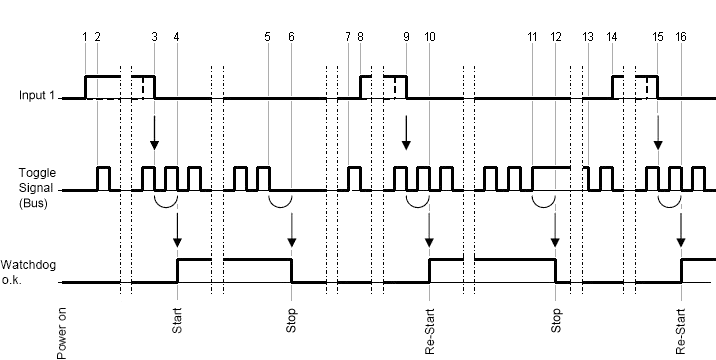Basic function principles
Pulse sequence monitoring (cycle)
- Monitoring is enabled with a falling edge at Input 1.
- If the pulse sequence is too slow (cycle time tP too long), the output relays switch off for a minimum switch-off time tAmin. The minimum switch-off time can be specified in register R36.
- If a pulse sequence (1 cycle) was recognized as correct, the output relays will only switch on again once monitoring is enabled again. This switching mode ensures that triggering of the watchdog remains recognizable.
- The two output contacts are looped into the control circuit of the switch-off relay.
Automatic self-start is prevented, since the switch-off function block has to be reset through an explicit manual intervention (monitoring enable).
 | Monitoring enable with falling edge Monitoring is enabled with a falling edge at Input 1. Therefore, monitoring cannot be enabled with a continuous signal (high) at Input 1! |
Example

Sequence
- Rising edge at input 1
- Toggle signal on the bus starts to toggle
- Falling edge at input 1 (monitoring enable)
- A full toggle cycle after the falling edge switches on the relays (Start)
- Toggle signal on the bus stops toggling and remains in low state
- The relays switch off after a missed toggle cycle (Stop)
- Toggle signal on the bus starts to toggle again
- Rising edge at input 1
- Falling edge at input 1 (monitoring enable)
- A full toggle cycle after the falling edge switches the relays back on again (Re-start)
- Toggle signal on the bus stops toggling and remains in high state
- The relays switch off after a missed toggle cycle (Stop)
- Toggle signal on the bus starts to toggle again
- Rising edge at input 1
- Falling edge at input 1 (monitoring enable)
- A full toggle cycle after the falling edge switches the relays back on again (Re-start)